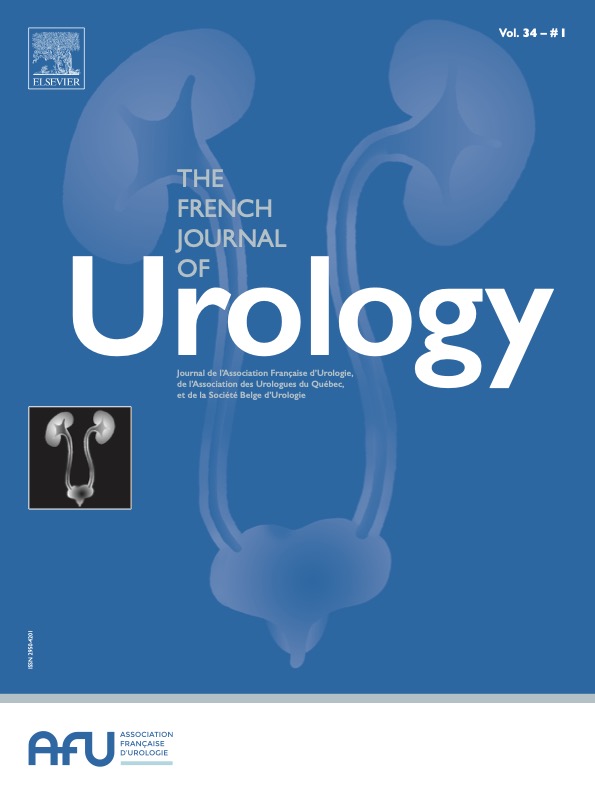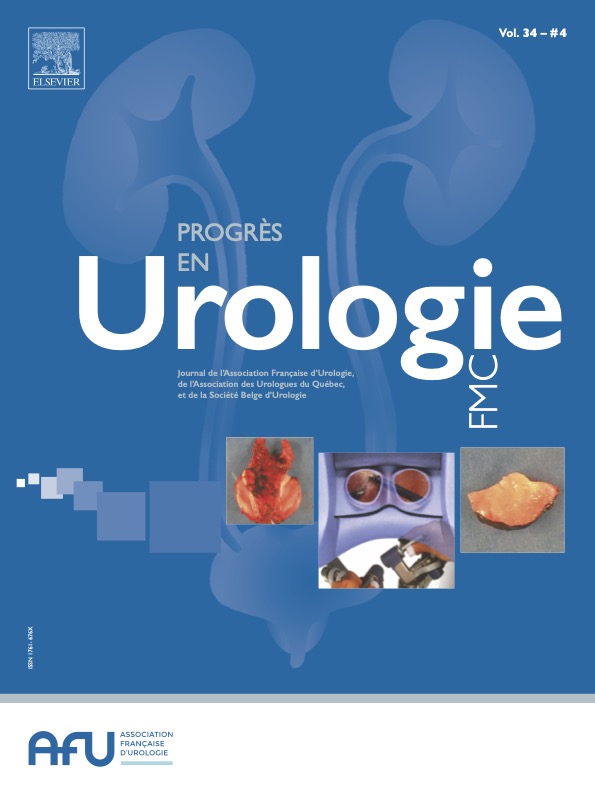| | | 2022 Recommendations of the AFU Lithiasis Committee: Endoscopic description of renal papillae and stones Recommandation 2022 du Comité lithiase de l’AFU : reconnaissance endoscopique des papilles et des calculs | | | | Endoscopic description is a modern concept in the diagnosis of urinary stone disease. It corresponds to the intraoperative visual analysis. A distinction is made between the endoscopic description of renal papillary abnormalities [1, 2, 3, 4, 5, 6] and of in situ stones, based on the morphological/structural descriptions by Daudon's group [7, 8, 9, 10, 11] adapted for endoscopy [6, 11, 12]. Only urologists can perform an endoscopic description of stones thanks to the excellent quality of vision and the almost complete exploration of the urinary cavities offered by digital flexible ureterorenoscopy. The endoscopic observation of renal papillary abnormalities allows determining the crystallization origin (homogeneous, heterogeneous on Randall's plaques, or intraductal), on the basis of the following specific features: • | Randall's plaques prevalence by ureteroscopy in patients with urinary stone disease ranges between 83 and 91% [ 5, 13]; | • | renal papilla erosion, anchored dark stones (calcium oxide monohydrate) and the presence of a Randall's plaques that represent the typical crystallization on Randall's plaque [ 3, 4, 5]. |
It is accepted that: • | crystallization on a Randall's plaques should most often suggest a dietary origin with insufficient diuresis [ 14, 15, 16, 17]; | • | intratubular crystallization (“plugs”), often linked to calcium phosphate stones, with hypercalciuria and hypocitraturia, is often associated with a disease at high risk of stone formation (e.g. distal renal tubular acidosis) [ 5, 18, 19]. |
These intraoperative visual observations are now an integral part of the urinary stone disease diagnostic approach, in addition to the morphological-compositional and spectrophotometric analysis that remains the reference investigation. Indeed, after the development/introduction of laser-based stone fragmentation methods, whole stones can now only rarely be analyzed. Therefore, information on the different components is lost, particularly in the case of mixed stones. Consequently, the endoscopic description of renal papillae and stones, which can be done only by an urologist, plays a crucial role in the etiological diagnostic approach. Several descriptive endoscopic classifications and/or scores exist in the literature [1]/[level of evidence (LOE) 3] [5, 20] (Figure 1).
Figure 1. Endoscopic description of renal papillae and stone formation.
Representative endoscopic images of the morphology of the most frequent stones are presented in Figure 2, Figure 3, Figure 4, Figure 5 (courtesy of Vincent Estrade) [7, 11, 21].
Figure 2. Calcium oxalate stones of type “Ia”, “Ia+IIb”, “Ia+Randall's plaque”, “IIa” and “IIb”.
Figure 3. Uric acid and oxalate-uric acid stones (“IIIa”, “IIIb”, “IIIab”, and mixed “III+Ia”).
Figure 4. Stones the morphology of which suggests a specific etiology (“IVa2”, “Ic”, “Ie” and “Id”).
Figure 5. Stones the morphology of which suggests a specific etiology (mixed “II+Iva/c”, “IVd”, “Va”, “Iva”, “IVb” and “IVc”).
Recommendation table 1 Endoscopic description has not been considered in international recommendations. The original studies identified with our search strategy were mostly descriptive and preliminary. They confirm the clinical usefulness of endoscopic observation due to its diagnostic, etiological and prognostic impact. La reconnaissance endoscopique (RE) est un concept diagnostique moderne de la lithiase urinaire. Elle correspond à l’analyse visuelle peropératoire. On distingue la reconnaissance endoscopique des anomalies rénales papillaires (REP) [1, 2, 3, 4, 5, 6] de celle des calculs (REC) in situ basée sur leur concordance avec les descriptions morpho-constitutionnelles de Daudon [7, 11], adaptées à l’endoscopie [6, 11, 12]. Seul l’urologue est à même de réaliser une REC grâce à l’excellente qualité de vision et l’exploration quasi complète des cavités urinaires que lui confère l’urétérorénoscopie au fibroscope souple numérique. La REP permet de déterminer l’origine (homogène, hétérogène sur plaque de Randall ou d’origine intraductale) de la cristallisation, en connaissant les spécificités suivantes: • | la prévalence des plaques de Randall chez les patients lithiasiques observée en urétéroscopie est de 83–91 % [ 5, 13] ; | • | les érosions papillaires, les calculs ancrés sombres (Ox Ca monohydraté) et la présence de plaque de Randall (PR) représentent la cristallisation typique sur PR [ 3, 4, 5]. |
Il est admis que: • | la cristallisation sur plaque de Randall doit faire évoquer le plus souvent une origine diététique avec diurèse insuffisante [ 14, 15, 16, 17] ; | • | la cristallisation d’origine intratubulaire (bouchons ou « plugs »), souvent liée à des calculs de phosphate de calcium, avec hypercalciurie et hypocitraturie, est souvent associée à une maladie à haut potentiel lithogène (ex: acidose tubulaire distale…) [ 5, 18, 19]. |
Ces examens visuels peropératoires font désormais partie intégrante de la démarche diagnostique de la lithiase en complément de l’analyse morpho-constitutionnelle et spectrophotométrique (MC SPIR) qui en demeure l’examen de référence. En effet, avec le développement des LASERs, la MC SPIR n’analyse que rarement un calcul entier. Elle perd donc une information de représentativité des différents composants en cas de calcul mixte notamment. Au travers de la reconnaissance endoscopique des papilles et des calculs (REPC) qu’il est le seul à pouvoir réaliser, l’urologue joue aujourd’hui un rôle capital dans cette démarche diagnostique étiologique. Plusieurs classifications endoscopiques descriptives et/ou scores existent dans la littérature. Classification Sx nPx Drx/i/px (cf. Figure 1) [1]/NP3 [5, 20].
Figure 1. Classification Sx nPx Drx/i/px, d’après [5]. S représente le type de calculs papillaires observés, n le nombre de papilles anormales dans le même rein et leur type (P), et D les dépôts incluant la quantité de plaques de Randall (rx) et la présence de dépôts intrapapillaires actifs (i) et de bouchons ou « plugs ». Deux exemples d’utilisation. Chaque exemple, correspond aux observations dans un rein entier, chez deux patients différents avec des mécanismes de lithogenèse différents. Le premier suggère une cristallisation sur les plaques de Randall. Le second suggère une cristallisation intra tubulaire.
Images endoscopiques caractéristiques des morphologies des calculs les plus fréquents (cf. Figure 2, Figure 3, Figure 4, Figure 5 ; remerciements à Vincent Estrade) [7, 11, 21].
Figure 2. Calculs oxalo-calciques Ia, Ia+IIb, Ia+plaque de Randall, IIa et IIb.
Figure 3. Calculs uriques et oxalo-uriques (IIIa, IIIb, IIIab et mixtes III+Ia).
Figure 4. Calculs dont la morphologie évoque une étiologie particulière (IVa2, Ic, Ie et Id).
Figure 5. Calculs dont la morphologie évoque une étiologie particulière (mixte (II+IVa)c, IVd, Va).
La Reconnaissance Endoscopique (RE) n’est pas encore abordée dans les recommandations internationales. Les études originales identifiées par la stratégie bibliographique sont des études le plus souvent descriptives et préliminaires. Elles confirment l’utilité clinique de la RE compte tenu de son impact diagnostique étiologique ainsi que pronostique. Tableau de Recommendation 1 The authors declare that they have no competing interest. | | | |
Recommendation table 1 - Recommendations on “Endoscopic description of renal papillary abnormalities and stones” [22, 23, 24, 25, 26, 27, 28].
|
Légende :
1This recommendation, proof of concept in the quoted studies, remains an expert opinion despite the level of evidence.
|
|

Tableau de Recommendation 1 - Recommandations « Reconnaissance endoscopique des REPC et des REC » [22, 23, 24, 25, 26, 27, 28].
|
Légende :
2This recommendation, proof of concept in the quoted studies, remains an expert opinion despite the level of evidence.
|
|
 | |
| Almeras C., Daudon M., Ploussard G., Gautier J.R., Traxer O., Meria P. Endoscopic description of renal papillary abnormalities in stone disease by flexible ureteroscopy: a proposed classification of severity and type World J Urol 2016 ; 34 : 1575-1582 [cross-ref] | | | Jaeger C.D., Rule A.D., Mehta R.A., Vaughan L.E., Vrtiska T.J., Holmes D.R., et al. Endoscopic and pathologic characterization of papillary architecture in struvite stone formers Urology 2016 ; 90 : 39-44 [inter-ref] | | | Cohen A.J., Borofsky M.S., Anderson B.B., Dauw C.A., Gillen D.L., Gerber G.S., et al. Endoscopic evidence that randall's plaque is associated with surface erosion of the renal papilla J Endourol 2017 ; 31 : 85-90 [cross-ref] | | | Borofsky M.S., Williams J.C., Dauw C.A., Cohen A., Evan A.C., Coe F.L., et al. Association between randall's plaque stone anchors and renal papillary pits J Endourol 2019 ; 33 : 337-342 [cross-ref] | | | Almeras C., Daudon M., Estrade V., Gautier J.R., Traxer O., Meria P. Classification of the renal papillary abnormalities by flexible ureteroscopy: evaluation of the 2016 version and update World J Urol 2021 ; 39 : 177-185 [cross-ref] | | | Almeras C., Pradere B., Estrade V., Meria P.On behalf of the Lithiasis Committee of The French Urological A Endoscopic Papillary Abnormalities and Stone Recognition (EPSR) during flexible ureteroscopy: a comprehensive review J Clin Med 2021 ; 10 | | | Corrales M., Doizi S., Barghouthy Y., Traxer O., Daudon M. Classification of stones according to michel daudon: a narrative review Eur Urol Focus 2021 ; 7 : 13-21 [cross-ref] | | | Daudon M., Jungers P., Bazin D., Williams J.C. Recurrence rates of urinary calculi according to stone composition and morphology Urolithiasis 2018 ; 46 : 459-470 [cross-ref] | | | Cloutier J., Villa L., Traxer O., Daudon M. Kidney stone analysis: “Give me your stone I will tell you who you are!”. World J Urol 2015 ; 33 : 157-169 [cross-ref] | | | Daudon M., Dessombz A., Frochot V., Letavernier E., Haymann J.-P., Jungers P., et al. Comprehensive morpho-constitutional analysis of urinary stones improves etiological diagnosis and therapeutic strategy of nephrolithiasis C R Chim 2016 ; 19 : 1470-1491 [inter-ref] | | | Estrade V., Denis de Senneville B., Meria P., Almeras C., Bladou F., Bernhard J.C., et al. Toward improved endoscopic examination of urinary stones: a concordance study between endoscopic digital pictures vs microscopy BJU Int 2021 ; 128 (3) : 319-33010.1111/bju.15312Epub 2020 Dec 26. PMID: 33263948; PMCID: PMC8451759.
[cross-ref] | | | Estrade V., Daudon M., Richard E., Bernhard J.C., Bladou F., Robert G., et al. Towards automatic recognition of pure and mixed stones using intra-operative endoscopic digital images BJU Int 2022 ; 129 : 234-242 [cross-ref] | | | Matlaga B.R., Williams J.C., Kim S.C., Kuo R.L., Evan A.P., Bledsoe S.B., et al. Endoscopic evidence of calculus attachment to Randall's plaque J Urol. 2006 ; 175 : 1720-1724discussion 4.
[cross-ref] | | | Kuo R.L., Lingeman J.E., Evan A.P., Paterson R.F., Parks J.H., Bledsoe S.B., et al. Urine calcium and volume predict coverage of renal papilla by Randall's plaque Kidney Int 2003 ; 64 : 2150-2154 [cross-ref] | | | Coe F.L., Worcester E.M., Evan A.P. Idiopathic hypercalciuria and formation of calcium renal stones Nat Rev Nephrol 2016 ; 12 : 519-533 [cross-ref] | | | Bouderlique E., Tang E., Perez J., Coudert A., Bazin D., Verpont M.C., et al. Vitamin D and calcium supplementation accelerates Randall's plaque formation in a murine model Am J Pathol 2019 ; 189 : 2171-2180 [cross-ref] | | | Siener R., Hesse A. Fluid intake and epidemiology of urolithiasis Eur J Clin Nutr 2003 ; 57 (Suppl 2) : S47-S51 | | | Dessombz A., Letavernier E., Haymann J.P., Bazin D., Daudon M. Calcium phosphate stone morphology can reliably predict distal renal tubular acidosis J Urol 2015 ; 193 : 1564-1569 [cross-ref] | | | Evan A.P., Lingeman J., Coe F., Shao Y., Miller N., Matlaga B., et al. Renal histopathology of stone-forming patients with distal renal tubular acidosis Kidney Int 2007 ; 71 : 795-801 [cross-ref] | | | Borofsky M.S., Paonessa J.E., Evan A.P., Williams J.C., Coe F.L., Worcester E.M., et al. A proposed grading system to standardize the description of renal papillary appearance at the time of endoscopy in patients with nephrolithiasis J Endourol 2016 ; 30 : 122-127 [cross-ref] | | | Estrade V., Daudon M., Traxer O., Meria P., members A.C. Why should urologist recognize urinary stone and how? The basis of endoscopic recognition Prog Urol–FMC 2017 ; 27 : F26-F35 | | | Carpentier X., Meria P., Bensalah K., Chabannes E., Estrade V., Denis E., et al. [Update for the management of kidney stones in 2013 Lithiasis Committee of the French Association of Urology]. Prog Urol 2014 ; 24 : 319-326 [cross-ref] | | | Keller E.X., Doizi S., Villa L., Traxer O. Which flexible ureteroscope is the best for upper tract urothelial carcinoma treatment? World J Urol 2019 ; 37 : 2325-2333 [cross-ref] | | | Talso M., Proietti S., Emiliani E., Gallioli A., Dragos L., Orosa A., et al. Comparison of Flexible Ureterorenoscope Quality of Vision: An In Vitro Study J Endourol 2018 ; 32 : 523-528 [cross-ref] | | | Coe F.L., Evan A.P., Worcester E.M., Lingeman J.E. Three pathways for human kidney stone formation Urol Res 2010 ; 38 : 147-160 [cross-ref] | | | Strohmaier W.L., Hörmann M., Schubert G. Papillary calcifications: a new prognostic factor in idiopathic calcium oxalate urolithiasis Urolithiasis 2013 ; 41 : 475-479 [cross-ref] | | | Kim S.C., Coe F.L., Tinmouth W.W., Kuo R.L., Paterson R.F., Parks J.H., et al. Stone formation is proportional to papillary surface coverage by Randall's plaque J Urol 2005 ; 173 : 117-119discussion 9.
[cross-ref] | | | Ciudin A., Luque M.P., Salvador R., Diaconu M.G., Franco A., Constantin V., et al. Abdominal computed tomography--a new tool for predicting recurrent stone disease J Endourol 2013 ; 27 : 965-969 [cross-ref] | |
| | | | | |
© 2023
Elsevier Masson SAS. Tous droits réservés. | | | | |
|









